Giochi dell'Oca e di percorso
(by Luigi Ciompi & Adrian Seville)
(by Luigi Ciompi & Adrian Seville)

|
Giochi dell'Oca e di percorso
(by Luigi Ciompi & Adrian Seville) |

|
 |

Torna alla ricerca giochi (back to game search) |
 |
| Novo (Il) et Piacevole Gioco del Pela il Chiv | ||
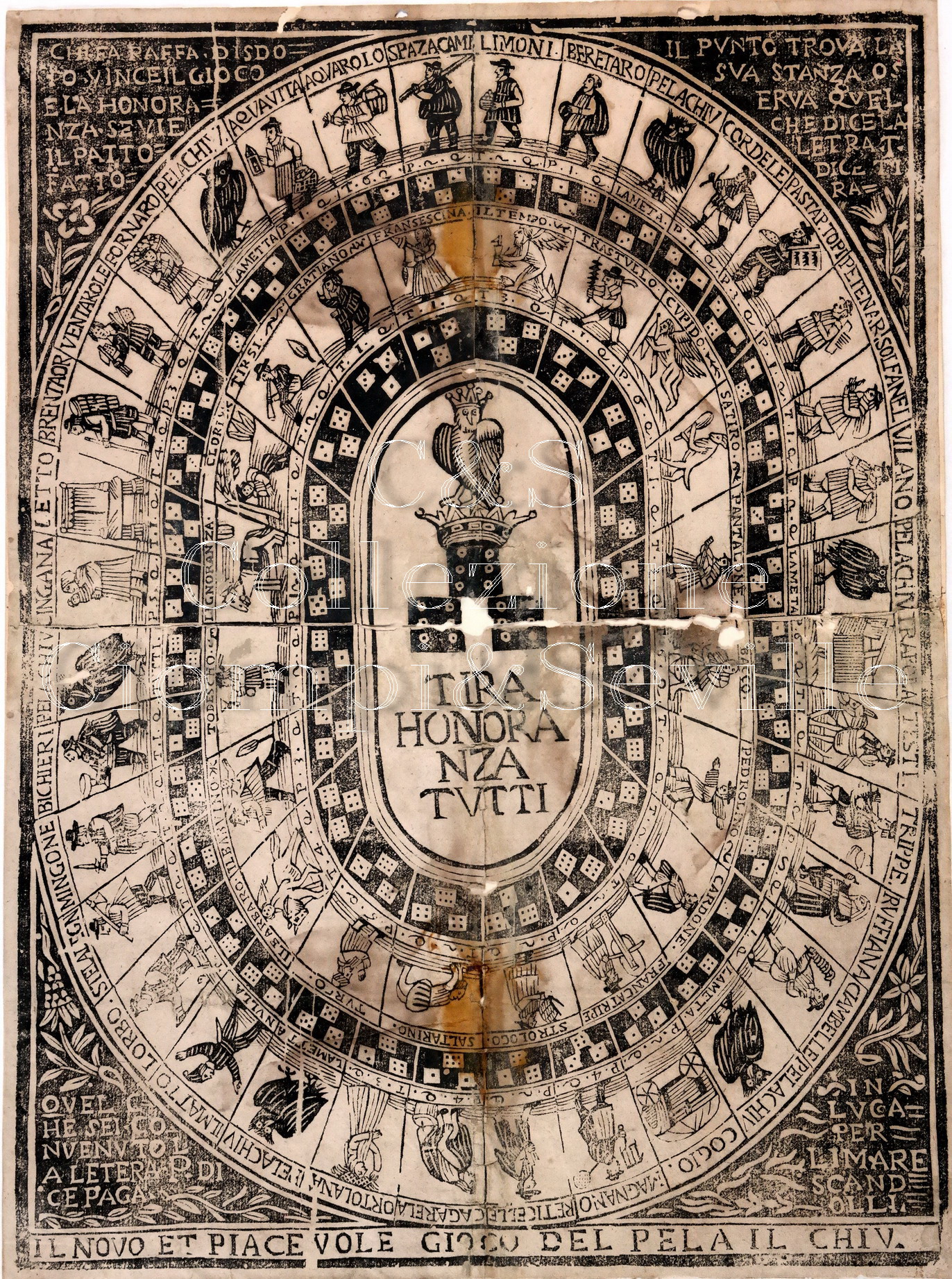 |
Versione stampabile
 |
Invia una segnalazione

|
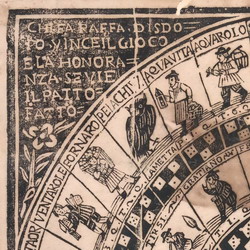 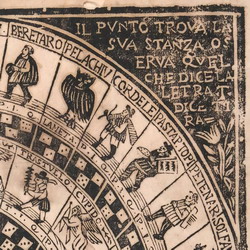 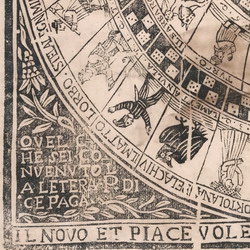 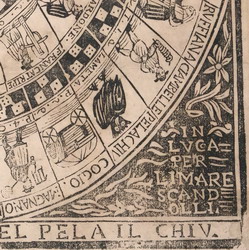 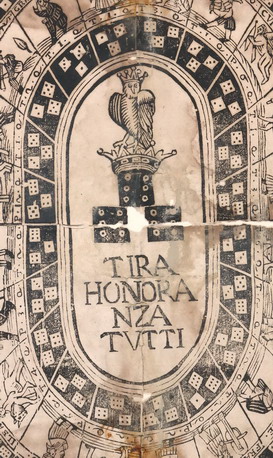 |
primo autore: | Anonimo |
| secondo autore: | Marescandoli | |
| anno: | 1700/50 | |
| luogo: |
Italia-Lucca |
|
| periodo: | XVIII secolo (1°-2°/4) | |
| percorso: | Gioco con i dadi | |
| materiale: | carta (paper) (papier) | |
| dimensioni: | 467X350 | |
| stampa: | Stampa su legno (bois gravé) (woodcut) | |
| luogo acquisto: | ||
| data acquisto: | ||
| dimensioni confezione: | ||
| numero caselle: | 56 | |
| categoria: | Lotterie, fortuna, gioco d'azzardo | |
| tipo di gioco: | Gioco con i dadi | |
| editore: | Marescandoli | |
| stampatore: | Tipografia Marescandoli, Lucca | |
| proprietario: | Collezione A. Seville | |
| autore delle foto: | A. Seville | |
| numero di catalogo: | 2728 | |
| descrizione: |
Gioco di 56 caselle non numerate disposte in due ellissi (ovati). Ogni casella presenta una figura ed una combinazione di dadi. Le combinazioni vincenti o perdenti sono indicate con le sigle P (paga), T (tira). La sigla Q (quattrini) indica la posta da pagare o tirare. Il nome del gioco significa "spennare la civetta" e consiste nel lanciare tre dadi e raggiungere la posizione che corrisponde al lancio sull'ovale interno o esterno, per poi eseguire le istruzioni scritte: 'T' significa tira per prendere il numero di quattrini ('Q') indicato; 'P' significa paga. Un tiro di tre sei (raffa 666) prende tutto. REGOLE: negli angoli sul tavoliere e nelle singole caselle. Al centro: "TIRA HONORANZA TUTTI". In basso titolo: "Il NOVO ET PIACEVOLE GIOCO DEL PELA IL CHIV". In basso a sinistra: "QUEL CHE SEI . CONVENUTO LA LETTERA .P. DICE PAGA"; a destra: "IN LUCCA PER LI MARESCANDOLLI; In alto a sinistra: "CHI FA RAFFA . DISDOTO VINCE IL GIOCO E LA HONORANZA . SE VI E IL PATTO FATTO"; In alto a destra: "IL PUNTO TROVA LA SUA STANZA OSERVA QUEL CHE DICE LA LETRA .T. DICE TIRA". Vedi esemplare Collezione British Museum Arch. n°1102. CASELLE: con combinazioni di dadi. Ellissi esterna (in senso antiorario): LIMONI: T.2.Q. (3,4,5); SPAZACAMI: P.2.Q. (2,5,4); AQUAROLO: T.6.Q. (2,3,6); AQUAVITA: P.1.Q. (4,4,2); PELACHIV: LA METTA (1,1,1); FORNARO: T.2.Q. (5,2,3,); VENTAROLE: P.3.Q. (3,4,1); BRENTAOR: T.4.Q. (5,3,5); LETTO: T.1. Q. (2,3,1); CINGANA: P.5.Q. (3,3,2); PELACHIV: TUTTI (6,6,6); BICHIERI: T.1.Q. (3,1,5); MINGONE: T.2.Q. (4,4,5); STECALEGN: T.2.Q. (5,1,6,); L'ORBO: T.1.Q. (6,3,3); IL MATTO: NULLA (6,6,3); PELACHIV: LA METTA (5,5,5); ORTOLANA: T.3.Q. (4,2,6); CAGARELA: P.4.Q. (1,1,6); RETICELLE: P.2.Q. (4,1,4); MAGNANO: P.4.Q. (2,2,4); COGIO: P.2.Q. (1,2,2); PELACHIV: LA META' (4,4,4); CIAMBELLE: T.1.Q. (3,2,2); RVFFIANA: P.8.Q. (2,2,5); TRIPPE: T.2.Q. (6,2,2); TESTI: T.1.Q. (4,1,5); TRAPOLA: P.6.Q. (1,1,2); PELACHIV: LA META (3,3,3); VILANO: P.2.Q. (1,1,3); SOLFANEL: T.1.Q. (1,1,4); PETENAR: P.1.Q. (1,1,5); PASTA P(ER) TOPI: P.3.Q. (1,2,4); CORDELE: P.1.Q. (1,2,5); PELACHIV: LA META (2,2,2); BERETARO: P.1.Q. (1,6,2). Ellissi interna (in senso antiorario): IL TEMPO: T.3.Q. (5,4,5); FRANCESCINA: T.2.Q. (5,1,5); GRATIANO: T.1.Q. (3,3,1); TIRSI: T.2.Q. (5,2,5); CLORI: T.1.Q. (5,3,5); L IGNORANZA: P.12.Q. (6,5,4); TODESCHO: T.2.Q. (4,6,1); IL BABVINO: P.3.Q. (4,3,4); IL BARBARO: T.4.Q. (6,6,4); TURCO: P.6. Q. (6,5,6); IL SALTARINO: T.2.Q. (4,4,6); STROLOGO: P.2. Q. (4,6,3); FRANCATRIPE: T.2. Q. (6,1,6); CARDONE: T.2.Q. (6,5,2); PEDROLINO: T.2.Q. (5,6,3); BACCO: T.6.Q. (3,6,1); PANTALONE: T.3.Q. (6,2,6); SATIRO: T.1.Q. (5,5,6); CVPIDO: P.6.Q. (3,4,2); TRASTVLLO: T.1.Q. (3,3,4); REFERENZA 1 "British Museum"© The Trustees of the British Museum 1893, 0331. 102 Title: "Il Novo et Piacevole Gioco del Pela il Chiu". Materials: paper Techniques: woodcut Production person: Print made by Anonymous Date: 18thC Schools /Styles: Italian Description: Game board with four concentric ovals containing squares with dice, human figures or owls; in the centre a crowned owl atop a crown resting on three dice showing sixes. Woodcut. Inscription Content: Lettered with title at top and in centre beneath the owl "Tira/ Honoran/ za/ da Tutti". In the two top corners are the rules of the game. Dimensions: Height: 505 millimetres. Width: 358 millimetres Curator's comments: (Text from Michael Bury, 'The Print in Italy 1550-1620', BM 2001, cat. 103.) The name of the game means "pluck the owl". It involved throwing three dice, identifying the place that corresponded to the throw on either the inner or the outer oval and then carrying out the written instructions. 'T' means tira that is the instruction to take the number of quattrini ("Q") indicated; "P" means paga that is the instruction to pay out the number of quattrini indicated. A throw of three sixes takes all. The idea will have been to buy one of these prints and stick it down onto a hard surface of some kind in order to form a game-board. The game is listed in the Vaccari stocklist of 1614 as "Il giuoco del pela Chiù", along with a small group of other games, including the famous 'Oca' (Ehrle, 1908, p.62). It also appears in the 1648 De Rossi inventory documenting the division of the inheritance from Giuseppe de Rossi the elder (Consagra, 1993, p.512). It evidently remained popular, for there were boards still being produced in the eighteenth century (Bertarelli). The language of the inscriptions points to a source in north-east Italy. This example has the address of Giovanni Battista Panzera, an engraver and printer from Parma who had shop in the Borgo in Rome. A number of Brambilla's works carry his address. Perhaps as a result of his contacts in the north of Italy, he had copies made of other prints that had been published there, most importantly Agostino Carracci's two great engravings after Correggio: the Madonna of St Jerome and the Ecce Homo. Acquisition name: Donated by Lady Charlotte Schreiber. |
|
| bibliografia: |
1) CITOLINI, Alessandro: "La tipocosmia di Alessandro Citolini, da Serraualle". In Venetia: appresso Vincenzo Valgrisi, 1561, p. 484. 2) FRANCIOSINI,Lorenzo: "Vocabulario español e italiano", Volume 2 Roma: en la Emprenta de la Reu. Camera Apostolica, 1638, p. 428. 3) LA MARINIERE, de: "La Maison Academique: contenant un recueil general de tous les jeux divertissans pour se rejouyr agreablement dans les bonnes compagnies", par le sieur D.L.M. [de La Marinière]. A Paris: chez Robert de Nain et Marin Leché, M.DC.LIV 4) HOWELL, James: Lexicon tetraglotton, an English-French-Italian-Spanish dictionary. London: by J.G. for Samuel Thomson, 1660, p. 532. 5) VINCK, Eugène, Baron de: "Iconographie du Noble Jeu de l’Oye. Catalogue descriptif et raisonné de la Collection de Jeux formé par le Baron de Vinck". 126 Jeux du XVIIIe au débùt du XIXe siècle. FR. J. Olivier Libraire, 11 Rue des Paroissiens, Bruxelles, 1886. 6) D’ALLEMAGNE, H. R. : "Le Noble Jeu de l’Oie", Paris, Libraire Gruend, 1950. 7) NEGRI, Ilio – VERCELLONI, Virgilio: "I Giochi di Dadi d’Azzardo e di Passatempo dei Gentiluomini e dei Pirati" Introduzione di Caterina Santoro, Lerici Milano, 1958. 8) VON WILCKENS, L. : "Spiel, Spiele, Kinderspiel (exhibition catalogue)", Germanisches Nationalmuseums, Nuernberg, 1985. 9) Catalogo Mostra: "Costume e società nei giochi a stampa di Giuseppe Maria Mitelli", Electa Editori Umbri Associati 1988. 10) GODANI, Lorenza: "I Marescandoli di Lucca, 1635-1805", in "Culture del testo" N°8 (mag.-ago. 1997), p.29-60). 11) BERTI, Giordano - VITALI, Andrea: “La vite e il vino. Carte da gioco e giochi di carta”, Fondazione Lungarotti, Edigraf, Roma 1999. 12) BURY, Michael: “The Print in Italy: 1550-1620”, BM 2001. 13) BUIJNSTERS, P.J. and Buijnsters-Smets,L. : "Papertoys", Zwolle, Waanders, 2005. 14) PLOCK, Phillippa - SEVILLE, Adrian: "The Rothschild Collection of printed board games at Waddesdon Manor", in XIIIth Board Game Studies Colloquium, Paris, 14-17 April 2010. 15) DEPAULIS, Thierry: “Trois jeux imprimés du début du XVIIe siècle par la veuve Petit à Paris”, Arbeitskreis Bild Druck Papier , Band 16 2011 16) MILANO, Alberto: "Giochi da salotto. Giochi da osteria, nella vita milanese dal Cinquecento all'Ottocento". Edizioni Gabriele Mazzotta, Milano 2012. 17) DEPAULIS, Thierry: "Three early 17th-century printed games by the Veuve Petit in Paris". In: Of Boards and Men: Board Games Investigated. Proceedings of the XIIIth Board Game Studies Colloquium, Paris, 14-17 April 2010, collected and edited by "Thierry Depaulis", [Paris], 2012, p. 75-89. 18) DEPAULIS, Thierry: "Vaugeois, tabletier, connu et inconnu" (2e partie). Le Vieux Papier fasc. n°422, 2016. 19) PARLAK, Ömer Fatih: "The Image of the Turk in Early Modern Board Games and Playing Cards". PHD THESIS. Universitat Autonoma de Barcelona, 2019. 20) SEVILLE, Adrian: "The Game of the Owl". In: "Vieux Papier", Aprile - Giugno 2021. 21) MAK Wien, Museum |
|
Vai alla ricerca giochi Vai all'elenco autori